Among the world's rarest gems, natural conch pearls stand out for their mesmerizing colors, organic origin, and extraordinary rarity. Unlike traditional pearls cultivated from oysters, these precious stones are formed naturally within the Queen Conch mollusk, primarily found in the warm waters of the Caribbean Sea. With a distinctive flame-like pattern and a stunning range of pink hues, natural conch pearls are not only beautiful but also highly sought after by collectors and jewelry enthusiasts alike.
The Origin of Natural Conch Pearls
Where Do Natural Conch Pearls Come From?
Natural conch pearls originate from the Queen Conch (Strombus gigas), a large sea snail native to the tropical waters of the Caribbean Sea, the Gulf of Mexico, and parts of the southeastern United States. These marine creatures thrive in seagrass beds, where they feed and grow for up to 30 years. While most pearls come from oysters, natural conch pearls form in an entirely different type of mollusk—making them even more unique in the gemstone world.
How Are They Discovered?
Unlike cultured pearls, which are intentionally grown through human intervention, natural conch pearls are discovered accidentally when fishermen harvest Queen Conchs for their meat. Only one in every 10,000 conches contains a pearl, and even fewer meet the standards for gem-quality jewelry. This scarcity is what makes each natural conch pearl a true treasure from the sea.
How Natural Conch Pearls Are Formed
The Formation Process
Natural conch pearls form when an irritant, such as a grain of sand or parasite, enters the soft mantle tissue of the Queen Conch. In response, the mollusk begins to deposit layers of calcium carbonate in a fibrous structure. Over time, this process creates a solid, non-nacreous gem with a unique flame-like optical effect known as chatoyancy. This intricate formation process can take several years and rarely results in perfectly round pearls.
Why They Lack Nacre
Unlike traditional pearls, natural conch pearls do not contain nacre—the iridescent layer found in oyster pearls. Instead, they develop a wavy, concentric internal structure that gives them a distinct appearance and durability. This lack of nacre does not diminish their value; rather, it adds to their uniqueness among the world of gemstones.
The Distinctive Appearance of Natural Conch Pearls
Colors and Patterns
Natural conch pearls display a wide range of colors, including white, brown, yellow, and various shades of pink. The most prized specimens exhibit a vibrant pink hue, often referred to as the “conch pearl flame.” This flame effect is a visual phenomenon caused by the layered fibrous structure of the pearl, creating a shimmering, silk-like pattern under light.
Shapes and Sizes
Due to the irregular shape of the Queen Conch’s shell, natural conch pearls are rarely round. Most are oval, baroque, or elongated, making them ideal for unique jewelry designs. While sizes vary, pearls weighing over 10 carats are considered exceptional and command high prices at auctions and specialty jewelers.
Rarity and Conservation Concerns
Why Are Natural Conch Pearls Rare?
The extreme rarity of natural conch pearls stems from both their low occurrence rate and the declining population of Queen Conchs. Overfishing has led to stricter regulations on harvesting, especially in the United States, where catching Queen Conchs is now illegal. As a result, finding a gem-quality natural conch pearl has become increasingly difficult, further elevating their status among collectors and luxury jewelry designers.
Conservation Efforts
In recent years, conservationists have raised concerns about the sustainability of Queen Conch populations. Some countries have implemented quotas and seasonal bans to protect these mollusks from overexploitation. Scientists continue to explore ways to preserve these species while maintaining the delicate balance between nature and the jewelry trade.
Using Natural Conch Pearls in Jewelry
Pearl Selection and Design
- Each natural conch pearl is unique, requiring custom settings to highlight its individual beauty.
- Jewelers often pair these pearls with diamonds or other colored gemstones to enhance their natural luster.
- Due to their rarity, matching pairs for earrings or necklaces are extremely uncommon, making single-stone pieces more prevalent.
A Highlighted Product: Queen Conch Pearl Necklace
One standout piece featuring a natural conch pearl is the Queen Conch Pearl Necklace – 1.74ct with White Diamonds in 18K White Gold. This exquisite necklace showcases a beautifully formed pink conch pearl set against sparkling white diamonds, offering a luxurious yet rare accessory perfect for special occasions or collectors.
Conclusion: The Timeless Appeal of Natural Conch Pearls
Natural conch pearls remain among the most captivating and elusive treasures of the ocean. Their unique formation, breathtaking colors, and limited availability make them highly coveted in the world of fine jewelry. Whether worn as a statement piece or admired for their rarity, these pearls embody the mystery and beauty of the sea. As conservation efforts continue and awareness grows, the future of natural conch pearls remains tied to the health of the Queen Conch population—a reminder of the delicate balance between nature and luxury.
Frequently Asked Questions (FAQ)
Are Natural Conch Pearls Valuable?
Yes, natural conch pearls are considered valuable due to their rarity, unique appearance, and the difficulty in sourcing them. Pink pearls with visible flame structures and larger carat weights are especially prized.
Can You Wear Natural Conch Pearls Every Day?
While durable, natural conch pearls should be handled with care. They rank between 4 and 6 on the Mohs hardness scale, so it's best to avoid heavy impact or exposure to harsh chemicals.
How Can I Tell If a Conch Pearl Is Real?
Genuine natural conch pearls will display a flame-like chatoyancy and have a slightly rougher texture than cultured pearls. For authentication, consult a certified gemologist or use professional testing methods.


Leave a comment